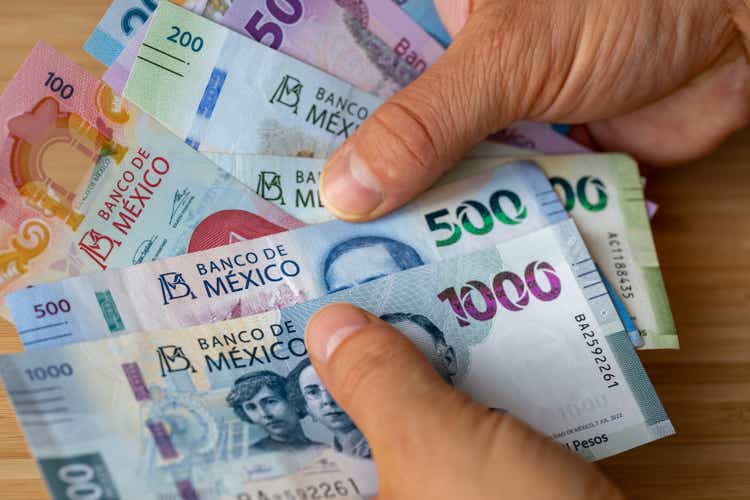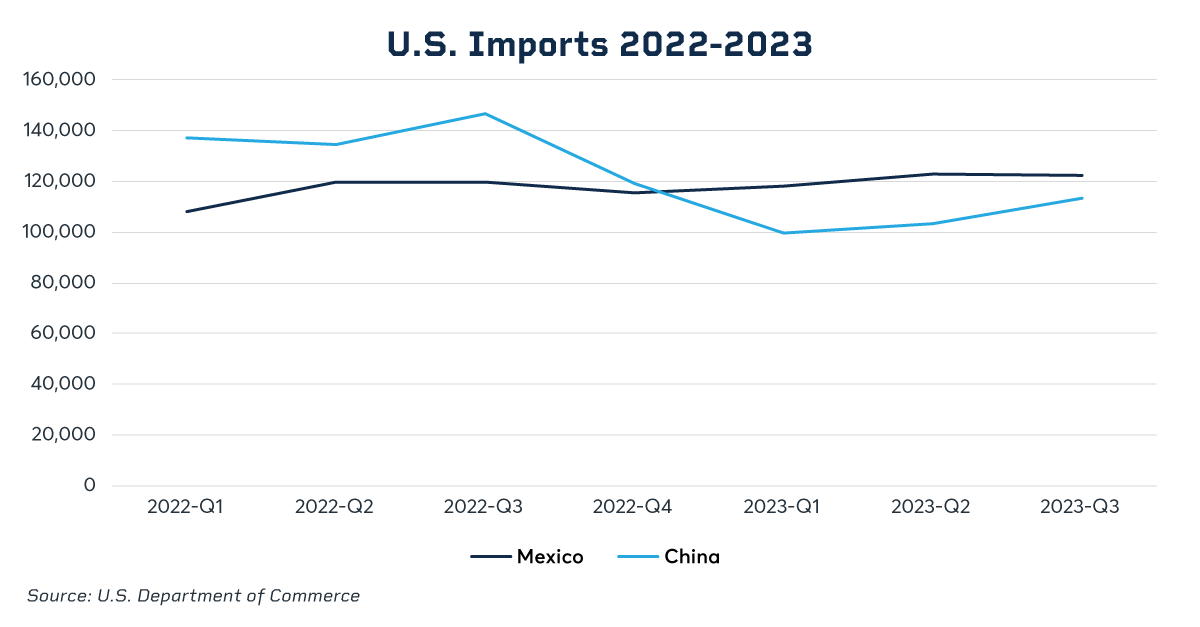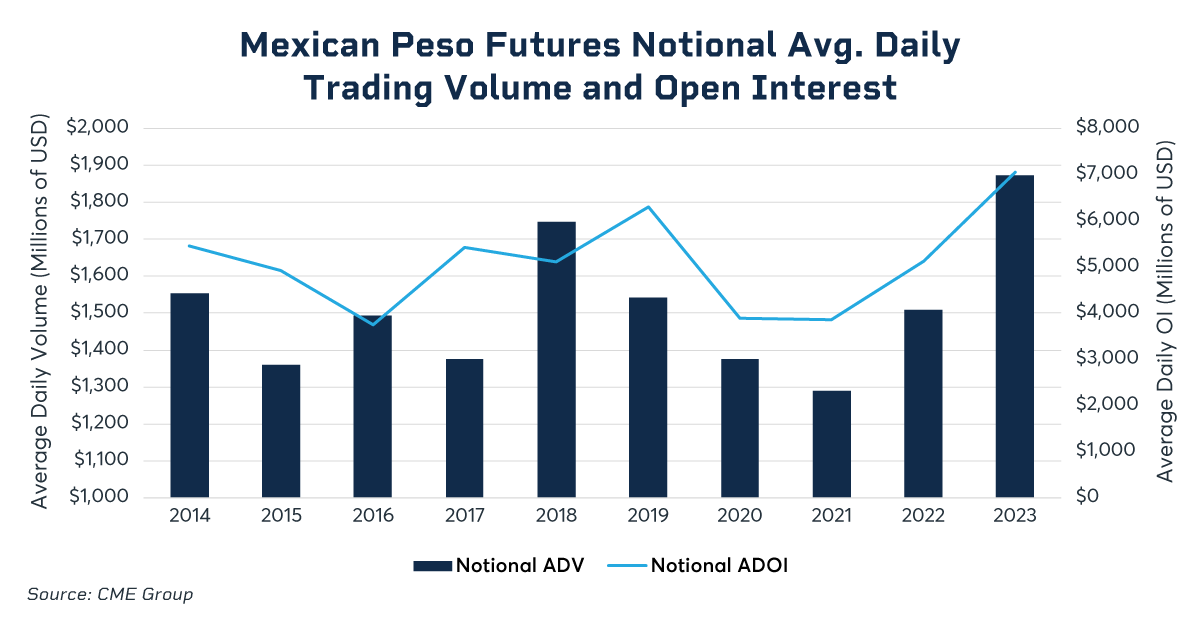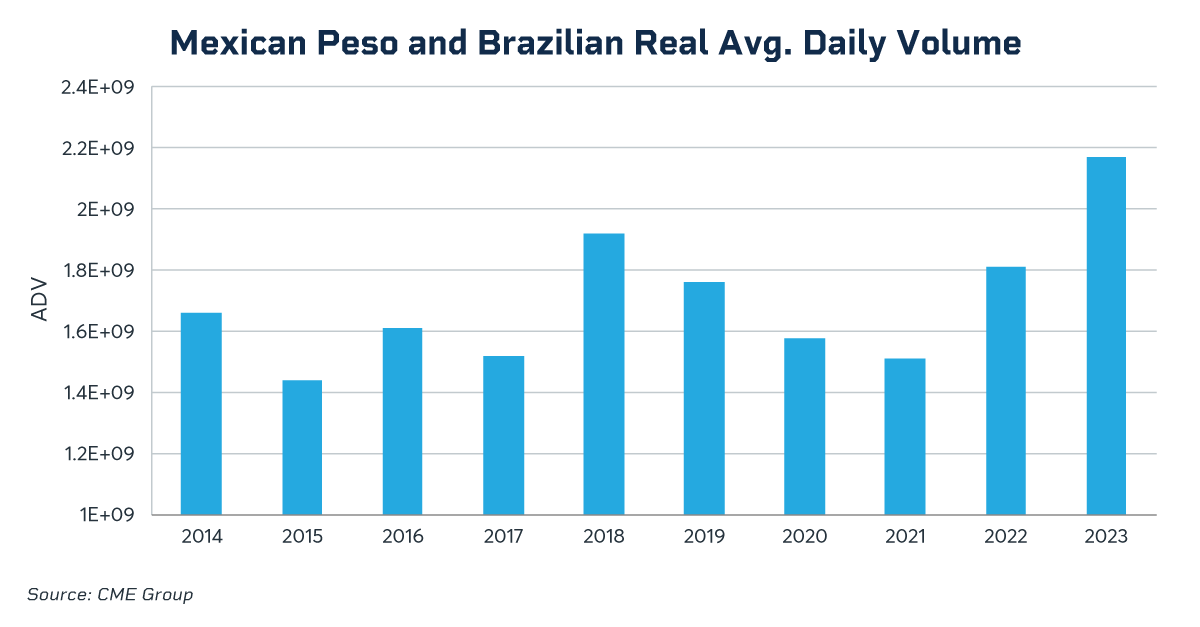Andrzej Rostek
Originally posted on February 15, 2024
By Ivan Castano
At A Glance:
- Mexico became the largest U.S. trading partner in 2023, totaling 15% of U.S. imports.
- As the Mexican peso climbed in 2023, trading in Mexican peso futures increased to $1.8 billion daily.
Mexico is poised to benefit from nearshoring, a growing trend that’s encouraging U.S. firms to manufacture goods close to home. That places a renewed focus on trade and increased attention from investors on the rising Mexican peso.
China, of course, has seen merchandise sales fall sharply amid pandemic-era supply-chain disruptions and increased tariffs from the U.S. This has caused product delays for many American companies, encouraging them to move sourcing South of the Border to ensure goods reach customers on time.
Mexico is an obvious choice, not only because it borders the U.S., meaning cargo trucks can deliver merchandise in about 12 hours, but also because it has a free-trade agreement called USMCA, formerly known as NAFTA.
In 2023, Mexico passed China as the largest importer to the U.S., accounting for 15% of total U.S. imports, according to data from the U.S. Commerce Department.

“We’ve seen a huge export jump in a very small amount of time,” said Jeff Grills, who oversees emerging-market debt for New York-based Aegon Asset Management.
Volatile Peso
As investors buy into the nearshoring frenzy, Mexico’s peso currency has soared in the past 12 months and become one of the most volatile trading pairs with the U.S. dollar, boosting opportunities for forex traders.
“Mexican peso futures are our strongest performing contract with a 24% increase in notional volume in 2023, and achieving a quarterly average daily volume record of $2.2 billion in Q4-23.,” said Paul Houston, Global Head of FX products at CME Group.
In fact, 2023 was a record year for Mexican peso futures at CME Group. The contract reached a record $1.8 billion in equivalent notional value average daily volume (ADV).

“CME Group’s liquidity in Mexican peso futures has been a key element to enhance our hedging activities, and thus to be able to heighten our client’s product offering,” said Alejandro Vigil, Head of FX at Mexican bank BBVA.
Buy side activity from asset managers, notably local hedge funds, asset managers and pension funds or “Afores” has also risen markedly, according to Houston, while interest from large Mexican corporates is also on the rise.
In 2023, CME Group reduced block trades’ minimum-price increments to offer more granularity and liquidity to the market while lowering trade costs. This has led to a 20x jump in institutional-client block trades in 2023, according to Houston.
One of the drivers of increased Peso trading also lies in the “carry trade,” where investors will capture the differential of interest rates in different countries by borrowing funds from a low interest rate country, and buying bonds in a country with higher rates. Mexico’s central bank began raising rates above that of the U.S. and other countries in 2021.
Trading in other Latin American currencies also reached new heights in 2023. Brazilian real futures reached a record $300 million in equivalent notional value ADV at CME Group.

“The continued growth of the Mexican and Brazilian economies combined with the current interest rate environment is driving more clients to trade CME Group FX futures,” said Houston.
Quadrupling Exports
The USMCA has unleashed a $1.3 trillion trade corridor between the U.S., Mexico and Canada, up from $343 billion when NAFTA was inked in 1994.
If nearshoring fully materializes, Mexico will be a big winner with manufacturing exports to U.S. buyers topping $600 billion in 2028 from about $455 billion now, according to Morgan Stanley (MS).
The bank also predicts investments could surge to $46 billion, boosting Mexico’s annual GDP to around 3% in the 2025-2027 period from an estimated 1.9% in 2022.
Mexican bank Banorte (OTCQX:GBOOY) is more sanguine, forecasting sales will surge by $168 billion in five years, driven by automotive, computer, transport, electric and telecoms exports. It expects the trend to transform Mexico’s economy and help it leapfrog ahead of others in the region which are seeing declining, post-pandemic growth such as Colombia and Chile.
Banorte plans to add 800 workers to meet financing demand for the supply-chain phenomenon, which already has manufacturing plants, or maquilas, in northern Mexico scrambling to fill orders.
“Many of the industrial and manufacturing parks in the country are at 100% capacity,” confirmed Carlos Gonzalez, research director at Mexican investment bank Monex. “We need much more infrastructure lending and investment.”
Interest rates may pose a challenge to growth projections, however. CME Group Chief Economist Erik Norland notes that the U.S. and Canada are unlikely to feel the full effects of monetary tightening until later in 2024 or 2025. As Mexico’s top trading partners, any downturn in those economies could be bad news for the peso.
Big EV Focus
A big manufacturing driver could be the burgeoning electric vehicle (EV) space. Tesla (TSLA) announced plans to build a $5 billion factory in Monterrey, a large industrial city bordering Texas and close to San Antonio. Not to stay behind, BMW (OTCPK:BAMXF) also intends to set up an 800 million euro EV battery factory in San Luis Potosi State that will also assemble its Neue Klasse mini sedan.
Other notable spending will come from third-party suppliers such as Germany’s Robert Bosch, which plans a $258-electronic brakes plant to supply Tesla, BMW and Nissan (OTCPK:NSANY). Samsung (OTCPK:SSNLF), meanwhile, also intends to earmark $500 million to boost home appliance production in Tijuana near San Diego, California, and on Queretaro, a fast-growing city a short drive from Mexico City.
Global Competition Looms
There is also competition. U.S. firms are increasingly looking at India, which is boosting its pro-business policies and infrastructure to compete with Mexico, as well as Costa Rica, which has built a massive textiles and apparel production hub to steal fashion clients from its northern neighbor.
Taxes are also prohibitively high for a nation where energy and road infrastructure remains poor, noted Andres Abadia, chief Latin America economist at Pantheon Macroeconomics.
“Mexico ranks 115 of 190 countries in terms of how easy it is for companies to have reliable power,” he explained. “This has to improve as well as transport logistics and security,” notably at ports where long-standing corruption has allowed contraband to flourish while gang activity continues to threaten freight carriers.”
Mining activity, notably in silver, could also witness a revival. With 6,300 metric tons (MT) extracted in 2022, Mexico is the world’s largest producer, followed by China. Investors, however, need to see improvements in Mexico’s legal framework and business environment before making new commitments, analysts say.
“The potential is huge but many things need to improve for Mexico to seize this nearshoring opportunity, such as legal conditions (i.e., stronger laws shielding foreign investors), logistics, infrastructure, and labor regulations,” Abadia pointed out.
Those challenges are not keeping investors from trading the MXN/USD pair at CME Group, boosting open interest for its futures and options to record highs.
“The peso is by far our strongest LatAm currency,” added Houston, “It’s the most liquid so it’s the most applicable to futures.”
Editor’s Note: The summary bullets for this article were chosen by Seeking Alpha editors.



